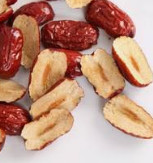Drying characteristics of jujube slices under different drying methods
Absrtact: In order to study the effects of different drying methods on the drying characteristics and quality of jujube slices, semi-dried Jun jujube was used as experimental material. After slicing, solar microwave drying equipment, vacuum freeze-drying and microwave drying experiments were carried out for different thickness jujube slices, and sensory evaluation and nutrient analysis were carried out for dried jujube slices.

Comprehensive sensory evaluation and drying characteristics analysis showed that the optimum experimental conditions for solar drying were solar wall collector type device, with the thickness of jujube slices 4 mm; vacuum freeze-drying with shelf temperature 40 C, the thickness of jujube slices 6 mm; microwave drying with microwave power 70 W, the thickness of jujube slices 6 mm. The results of nutrient composition test showed that the Vc content and total sugar content of jujube slices prepared by vacuum freeze-drying were the highest. The results can provide guidance for the actual drying of jujube slices.
Key words: microwave drying of jujube slices; Jun jujube; drying characteristics; nutritional components

Jujube, as one of the most characteristic and advantageous fruits in China, is very popular because of its rich nutritional components. With the rapid development of agricultural planting technology, the yield of jujube is increasing year by year. Due to the oversupply of market demand, semi-dried jujube has been hoarded in large quantities. Therefore, it is urgent to develop new varieties of jujube products. In recent years, crisp jujube, jujube slices, jujube powder and other products have been on the market. Most crisp jujube and jujube slices are made by frying. Although they taste crisp, they contain a lot of oil, which has adverse effects on health. Therefore, it is necessary to study the drying method of semi-dried jujube with high nutritional value and good taste.
In recent years, scholars have studied the drying characteristics of jujube products (whole jujube, sliced jujube, jujube powder) and the effects of drying methods on their quality, but fresh jujube is used as experimental material. Shen Jing et al. through comparing the four drying methods with comprehensive nutrient composition and sensory evaluation, concluded that the best drying methods for making crisp jujube slices from fresh winter jujube were microwave vacuum freezing and microwave vacuum expansion; Luo et al. considered the effects of various drying methods on texture, nutrition and sensory quality (color, aroma) of jujube slices comprehensively, and considered that the composite drying technology, i.e., intermittent vacuum microwave drying, could be used. To achieve complementary advantages.
Chen and other methods were used to optimize the processing conditions of spray drying method to produce jujube powder by response surface methodology, so that the moisture content, hygroscopicity, brightness and Vc content of the jujube powder were the best quality. Fang et al. studied the effect of power on shrinkage, density, Vc and browning degree of jujube slices dried by microwave. The results showed that the content of Vc, density and browning degree of jujube slices dried by high microwave power were higher than those dried by low microwave power, but the content of soluble solids was lower. Lee et al. used vacuum drying to study the water diffusion coefficient and drying activation energy of jujube slices at different temperatures.
Gao et al. studied the changes of organic acids, phenolic compounds, sugar, VE and beta carotene in jujube slices before and after oven drying, microwave drying, freeze drying and natural drying by high performance liquid chromatography. However, no studies on drying of semi-dried jujube slices have been reported. There are many kinds of jujube in China, up to 260 kinds. Among them, Junzao in Xinjiang is a big jujube with high content of Vc and total sugar, which is very popular with consumers.
In this study, the semi-dried jujube in Xinjiang was used as experimental material, and solar drying, vacuum freeze drying and microwave drying were used to drying jujube slices with different thickness under different drying conditions. The drying characteristics, sensory evaluation and nutritional value of jujube slices were compared in order to provide theoretical basis for industrial drying of semi-dried jujube.